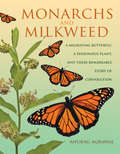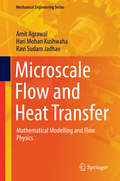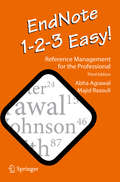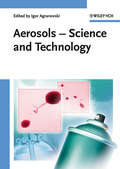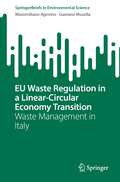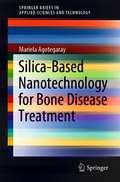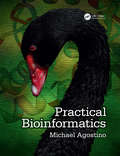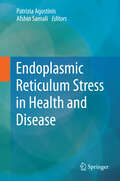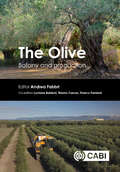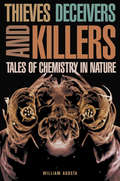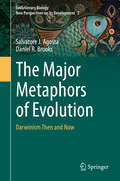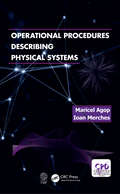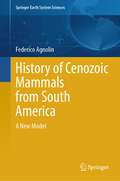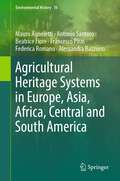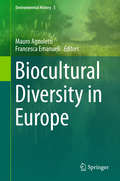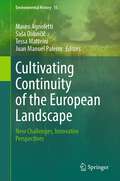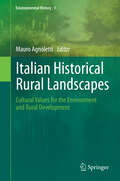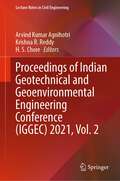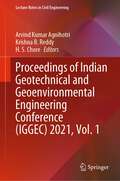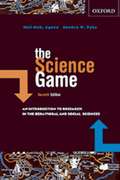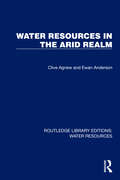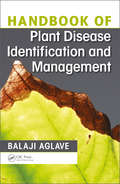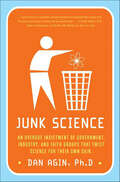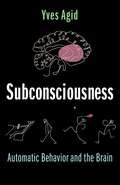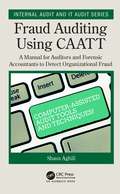- Table View
- List View
Monarchs and Milkweed: A Migrating Butterfly, a Poisonous Plant, and Their Remarkable Story of Coevolution
by Anurag AgrawalThe fascinating and complex evolutionary relationship of the monarch butterfly and the milkweed plantMonarch butterflies are one of nature's most recognizable creatures, known for their bright colors and epic annual migration from the United States and Canada to Mexico. Yet there is much more to the monarch than its distinctive presence and mythic journeying. In Monarchs and Milkweed, Anurag Agrawal presents a vivid investigation into how the monarch butterfly has evolved closely alongside the milkweed—a toxic plant named for the sticky white substance emitted when its leaves are damaged—and how this inextricable and intimate relationship has been like an arms race over the millennia, a battle of exploitation and defense between two fascinating species.The monarch life cycle begins each spring when it deposits eggs on milkweed leaves. But this dependency of monarchs on milkweeds as food is not reciprocated, and milkweeds do all they can to poison or thwart the young monarchs. Agrawal delves into major scientific discoveries, including his own pioneering research, and traces how plant poisons have not only shaped monarch-milkweed interactions but have also been culturally important for centuries. Agrawal presents current ideas regarding the recent decline in monarch populations, including habitat destruction, increased winter storms, and lack of milkweed—the last one a theory that the author rejects. He evaluates the current sustainability of monarchs and reveals a novel explanation for their plummeting numbers.Lavishly illustrated with more than eighty color photos and images, Monarchs and Milkweed takes readers on an unforgettable exploration of one of nature's most important and sophisticated evolutionary relationships.
Microscale Flow and Heat Transfer: Mathematical Modelling and Flow Physics (Mechanical Engineering Series)
by Amit Agrawal Hari Mohan Kushwaha Ravi Sudam JadhavThis book covers concepts and the latest developments on microscale flow and heat transfer phenomena involving a gas. The book is organised in two parts: the first part focuses on the fluid flow and heat transfer characteristics of gaseous slip flows. The second part presents modelling of such flows using higher-order continuum transport equations. The Navier-Stokes equations based solution is provided to various problems in the slip regime. Several interesting characteristics of slip flows along with useful empirical correlations are documented in the first part of the book. The examples bring out the failure of the conventional equations to adequately describe various phenomena at the microscale. Thereby the readers are introduced to higher order continuum transport (Burnett and Grad) equations, which can potentially overcome these limitations. A clear and easy to follow step by step derivation of the Burnett and Grad equations (superset of the Navier-Stokes equations) is provided in the second part of the book. Analytical solution of these equations, the latest developments in the field, along with scope for future work in this area are also brought out.Presents characteristics of flow in the slip and transition regimes for a clear understanding of microscale flow problems;Provides a derivation of Navier-Stokes equations from microscopic viewpoint;Features a clear and easy to follow step-by-step approach to derive Burnett and Grad equations;Describes a complete compilation of few known exact solutions of the Burnett and Grad equations, along with a discussion of the solution aided with plots;Introduces the variants of the Navier-Stokes, Burnett and Grad equations, including the recently proposed Onsager-Burnett and O13 moment equations.
EndNote 1-2-3 Easy!: Reference Management for the Professional
by Abha Agrawal Majid RasouliThis book is intended for healthcare professionals, biomedical researchers, health policy experts, and graduate students who frequently write and publish scientific manuscripts in peer reviewed journals. This new edition updates earlier versions with an emphasis on the most currently available Clarivate Analytics software application EndNote X9, a widely used reference management software. For first-time users of EndNote X9, this book is a comprehensive and well-illustrated instruction manual for getting started, including detailed instructions on installation, creating reference libraries, and ultimately creating complete and accurate citation-based bibliographies necessary to achieve successful peer reviewed publications. There is also a full chapter devoted to careful guidance for the growing practice of citing references from online internet sources. For existing “power users” of current and earlier versions of EndNote, this book provides quick and easy access to a comprehensive compendium of nuanced and advanced features of this powerful software, with an emphasis on providing greater ease and control in coordinating and curating research materials and bibliographies with research collaborators and scientific writing teams. The authors have also added new, state-of-the-art “how-to” guidance on a variety of methods of using EndNote, including PubMed, Google Scholar, Web of Science, Scopus and others. Like many legacy software systems, Clarivate Analytics has also begun to offer an online “desktop” version of EndNote, a topic which is now also covered in Chapter 10 (EndNote Online) of this new edition.
Aerosols: Science and Technology
by Igor AgranovskiThis self-contained handbook and ready reference examines aerosol science and technology in depth, providing a detailed insight into this progressive field. As such, it covers fundamental concepts, experimental methods, and a wide variety of applications, ranging from aerosol filtration to biological aerosols, and from the synthesis of carbon nanotubes to aerosol reactors. Written by a host of internationally renowned experts in the field, this is an essential resource for chemists and engineers in the chemical and materials disciplines across multiple industries, as well as ideal supplementary reading in graduate level courses.
EU Waste Regulation in a Linear-Circular Economy Transition: Waste Management in Italy (SpringerBriefs in Environmental Science)
by Massimiliano Agovino Gaetano MusellaWaste management is a topical issue worldwide. In recent years, several requests have been made by citizens and associations to political decision-makers regarding the need for a significant improvement in waste management methods. Particularly considering the significant increase in awareness of social and environmental impacts and the economic consequences of non-virtuous waste management. There is growing attention on legislation and regulation's role in the waste sector. Regulation can help companies and citizens achieve a faster, more effective, and more efficient transition from a linear economy, based on the take-make-dispose paradigm, to a circular economy, in which the potential of waste as resources and secondary raw materials is exploited. This book is set in the wake of economic literature that tackles the transition from the linear to the circular economy. It focuses on the downstream stages of the waste management process (i.e. the waste treatment phase). In this regard, it is proposed a journey through the history of European waste legislation to study the waste sector's transition dynamics from a selfish and no longer sustainable economic model based on rampant consumerism to a far-sighted sustainable model addressing the well-being of future generations. Studying the changes in European waste regulations leads us to ask ourselves the following questions: how has waste collection changed in recent years? What are the new regulatory challenges that must be addressed to achieve the objectives of a circular economy? How successful has the EU legislation been in fostering the transition from a linear to a circular economy? Finally, has the European environmental legislation sprung a convergence process among European countries towards the circular economy, or has the definition of targets fuelled the already marked differences between EU countries?
Silica-Based Nanotechnology for Bone Disease Treatment (SpringerBriefs in Applied Sciences and Technology)
by Mariela AgotegarayThis book addresses conventional treatments of bone diseases. It proposes nanotechnological tools based on the use of silica as a bioactive material for bone. The book links the physiological and anatomical aspects of the bone with the ancestral importance of the bone system. It describes associated pathologies and conventional treatments, emphasizing their shortcomings. The book gives future perspectives and applicable tools to the development of new nanomaterials.
Practical Bioinformatics
by Michael AgostinoPractical Bioinformatics is specifically designed for biology majors, with a heavy emphasis on the steps required to perform bioinformatics analysis to answer biological questions. It is written for courses that have a practical, hands-on element and contains many exercises (for example, database searches, protein analysis, data interpretation) to
Endoplasmic Reticulum Stress in Health and Disease
by Patrizia Agostinis Samali AfshinThe Endoplasmic Reticulum (ER) is an organelle with extraordinary signaling and homeostatic functions. It is the organelle responsible for protein folding, maturation, quality control and trafficking of proteins destined for the plasma membrane or for secretion into the extracellular environment. Failure, overloading or malfunctioning of any of the signaling or quality control mechanisms occurring in the ER may provoke a stress condition known as 'ER stress'. Accumulating evidence indicates that ER stress may dramatically perturb interactions between the cell and its environment, and contribute to the development of human diseases, ranging from metabolic diseases and cancer to neurodegenerative diseases, or impact therapeutic outcome. This book primarily focuses on the pathophysiology of ER stress. It introduces the molecular bases of ER stress, the emerging relevance of the ER-mitochondria cross-talk, the signaling pathways engaged and cellular responses to ER stress, including the adaptive Unfolded Protein Response (UPR), autophagy as well as cell death. Next the book addresses the role of ER stress in physiology and in the etiology of relevant pathological conditions, like carcinogenesis and inflammation, neurodegeneration and metabolic disease. The last chapter describes how ER stress pathways can be targeted for therapeutic benefit. Altogether, this book will provide the reader with an exhaustive view of ER stress biology and the latest insights in the role of ER stress in relevant human diseases.
The Olive: Botany and Production
by Giovanni Agosteo Barbera Giuseppe Angjelina Belaj Antonio Belcari Karim Barkaoui Giora Ben-Ari Alon Ben-Gal Giovanni Benelli Rita Biasi Iris Biton Konstantinos Blazakis Aureliano Bombarely Antonio Brunori Santa Olga Cacciola Angelo Canale Giovanni Caruso Dr Tiziano Caruso Nicola Cinosi Arnon Dag Ran Erel Daniela Farinelli Louise Ferguson Tommaso Ganino Jesus A Gil-Ribes Calero José Gómez Riccardo Gucci Consolación Guerrero Panagiotis Kalaitzis Maurizio Lambardi Lauri Pierre-Eric Lorenzo León Bianco Riccardo Lo Enrico Maria Lodolini Francisco Luque Hanene Mairech Picchi Malayka Giulia Marino Roberto Mariotti Francesco Paolo Marra G Medina-Alonso José Mercado Maurizio Micheli Soraya Mousavi Monji Msallem Dvora Namdar Isabel Narváez Elena Palomo-Ríos Ruggero Petacchi Pierluigi Pierantozzi Malayka Samantha Picchi Amalia Rosa Piscopo Fernando Pliego-Alfaro Primo Proietti Alessandro Ragazzi Pilar Rallo Hava F Rapoport Luca Regni Laia Ribalta A. Rosati Patrizia Sacchetti Luca Sebastiani Alicia Serrano Giuseppe Surico Luca Testi Maria Cristina Valeri Andrea Vitale Uri Yermiyahu Hande Yilmaz-Düzyaman Valeria Zeni Isaac Zipori James Friel Raul De Rosa Salvatore Camposeo Garcia Sergio CastroThe European or Mediterranean cultivated olive (Olea europaea L., subsp. europaea, var. europaea) is an ancient crop notable for its early domestication. Today, hundreds of olive varieties are grown to produce high-quality fruit for oil and table olives for human consumption. Over the last 30 years, the olive industry has undergone profound innovation due to scientific and technical advances, particularly in genomics, breeding, orchard management, mechanization and agro-ecology. Not all these developments are currently available to smaller producers. Outside the Mediterranean Basin, where it has been present for over 6,000 years, olive cultivation has spread to many other countries. These new olive-growing areas are helping further the expansion of the industry, due to increased awareness of the nutritional and health properties of extra virgin olive oil. This book is a much-needed update on olive biology and cultivation, with contributions from leading international experts, and includes: Genetics and breeding Olive propagation and nursery Planting olive orchards Horticultural management of olive orchards Plant protection Olive by-products Multifunctionality of olive groves and ecosystem services The Olive: Botany and Production is an invaluable resource for researchers and students in horticulture and agriculture, in addition to producers involved in olive orchard management.
Thieves, Deceivers, and Killers: Tales of Chemistry in Nature
by William AgostaThe tobacco plant synthesizes nicotine to protect itself from herbivores. The female moth broadcasts sex pheromones to attract a mate, while a soldier ant deploys an alarm pheromone to call for help. The carbon dioxide on a mammal's breath beckons hungry ticks and mosquitoes, while a flower's fragrance speaks to the honey bee. Indeed, much of the communication that occurs within and between various species of organisms is done not by sight, sound, or touch, but with chemicals. From mating to parenting, foraging to self-defense, plant and animal activities are accomplished largely by the secretion or exchange of organic chemicals. The fascinating and fast-developing science that encompasses these diverse phenomena is introduced here, by William Agosta, in a series of remarkable stories absolutely accessible to the general reader yet revelatory to chemists and biologists. Among Agosta's characters are the organisms that steal, counterfeit, or interpret the chemical signals of other species for their own ends. We learn of seeds that mimic ant odors to facilitate their own dispersion and flies that follow the scent of truffles to lay their eggs. We read about pit vipers that react in terror when their flicking tongues detect a king snake, and slave-making ants incapable of finding their own food. And we meet ice-age people who ate birch fungus to relieve whipworms and early human hunters who used the urine of wolves to maneuver deer to favorable sites. Agosta also chronicles the rapid development of the applied science that makes use of chemical ecology. As researchers deepen our understanding of the biological world, they are making economically significant discoveries (such as enzymes that remain stable in extreme heat), finding ways to reduce our reliance on manufactured pesticides, identifying new uses for traditional medicines, and developing sophisticated new pharmaceuticals effective in treating malaria and several cancers. On the horizon are antiviral agents derived from the chemical defenses of marine species. From the exploits of flies to the high-stakes effort to cure human disease, Agosta's tour of chemical ecology grants any reader entrance to the invisible realm where chemistry determines life and death.
The Major Metaphors of Evolution: Darwinism Then and Now (Evolutionary Biology – New Perspectives on Its Development #2)
by Salvatore J. Agosta Daniel R. BrooksThis book presents a unified evolutionary framework based on three sets of metaphors that will help to consolidate discussions on evolutionary transitions.Evolution is the unifying principle of life, making identifying ways to apply evolutionary principles to tackle existence-threatening crises such as climate change crucial. A more cohesive evolutionary framework will further the discussions in this regard and also accelerate the process itself.This book lays out a framework based on three dualistic classes of metaphors – time, space, and conflict resolution. Evolutionary transitions theory shows how metaphors can help us understand selective diversification, as Darwin described with his “tree of life”. Moreover, the recently proposed Stockholm paradigm demonstrates how metaphors can help shed light on the emergence of complex ecosystems that Darwin highlighted with his “tangled bank” metaphor. Taken together, these ideas offer proactive measures for coping with existential crises for humanity, such as climate change.The book will appeal to biologists, philosophers and historians alike.
Operational Procedures Describing Physical Systems
by Marciel Agop Ioan MerchesThe authors examine topics in modern physics and offer a unitary and original treatment of the fundamental problems of the dynamics of physical systems, as well as a description of the nuclear matter within a framework of general relativity. They show that some physical phenomena studied at two different resolution scales (e.g. microscale, cosmological scale), apparently with no connection between them, become compatible by means of the operational procedures, acting either as some ”hidden” symmetries, or harmonic-type mappings. The book is addressed to the students, researchers and university/high school teachers working in the fields of mathematics, physics, and chemistry.
History of Cenozoic Mammals from South America: A New Model (Springer Earth System Sciences)
by Federico AgnolinThe Cenozoic history of South America faunas mainly rests on the evidence yielded by the study of fossil mammals. Following the seminal work of William D. Matthew, George G. Simpson established the slogan “Splendid Isolation” for describing the evolutionary history of South American faunas. He envisaged South America (as well as other Southern Hemisphere landmasses) as dead ends in the evolution and geographical expansion of animals and plants that since the Mesozoic come in successive migratory waves from the North.More than 40 years passed away from the last important contribution by Simpson (1980). Since then, in spite to the exponential increase in biological, paleontological and geological knowledge, and an incredibly new number of fossils, his scheme remained almost unpolluted and most recent books regarding the palaeobiogeography of South American vertebrates follow this paradigm nearly without criticism.However, the factthat South America was joined to Africa, Australia, Antarctica and India during most of the Cretaceous, and that it was still connected Australia (via Antarctica) and probably Africa up to the Paleogene, together with the large number of shared biotic components between these landmasses, point in favor of a different paleobiogeographical scenario.The book aims to demonstrate that during the Paleogene (and most of the Neogene) the nature and evolutionary history of South American vertebrates is by far much more intricate than previously envisaged. As will be shown, new evidence suggests that southern landmasses may have played an important role in the early evolution and radiation of extant mammal clades. This book is not written to conform with the ideal of a technical manual or a review, and is not carried forward to collect all that has been said before. The main goals are to criticize the current Palaeobiogeographic Model of Vertebrate Settlement of South America, and to propose a new vision based on the evidence provided by the natural world in the last decades.
Agricultural Heritage Systems in Europe, Asia, Africa, Central and South America (Environmental History #16)
by Mauro Agnoletti Antonio Santoro Beatrice Fiore Francesco Piras Federica Romano Alessandra BazzurroAgriculture is often considered as one of the main threats to ecosystems. Unsustainable farming practices often result in habitat loss, inefficient use of water, soil degradation, pollution, genetic erosion, among other negative impacts on human life, including hunger, low food quality, reduced access to food resources, as well as the abandonment of rural areas. Nevertheless, when agriculture is practiced in a sustainable way, it can contribute to the preservation of many habitats, to the protection of watersheds, to the preservation and improvement of soil health.The use of sustainable and ecological practices is the key feature distinguishing traditional agriculture from intensive one. It may not provide very high yields, but ensures sustainable harvests over time, thanks to time-tested technologies and traditional know-hows and also represent examples of adaptation to harsh environmental conditions. Based on this approach, in 2002, FAO launched the concept of Globally Important Agricultural Heritage Systems (GIAHS) Programme, to identify and safeguard agricultural systems that are ensuring food and livelihood security, while maintaining magnificent landscapes, agricultural biodiversity, traditional knowledge, cultural and social values.This book presents 18 examples of these traditional agriculture systems around the world, with a special focus on Europe, Asia, Africa, Central and South America, as a result of the “GIAHS Building Capacity” project co-funded by the Italian Agency for Development Cooperation (AICS) and carried out by the Department of Agriculture, Food, Environment and Forestry (DAGRI) of the University of Florence (Italy).
Biocultural Diversity in Europe (Environmental History #5)
by Mauro Agnoletti Francesca EmanueliThe book collects a selection of the papers presented at the meeting held in the context of the Joint Programme on the Links between Biological and Cultural Diversity (JP-BiCuD). Recognizing the inextricable link between biological and cultural diversity, the United Nations Educational Scientific and Cultural Organization (UNESCO) and the Secretariat of the Convention on Biological Diversity (SCBD) joined forces, and in 2010 launched the Joint Programme on the Links between Biological and Cultural Diversity (JP-BiCuD). The first meeting for the implementation of the JP-BiCuD was held in Florence (Italy) in April 2014 and produced the UNESCO-sCBD Florence Declaration, which highlights the concept of biocultural diversity. The European rural territory is predominantly a biocultural, multi-functional landscape, providing a crucial and effective space for integration of biological and cultural diversity, suggesting the need to revise some of the current strategies for the assessment and management of biodiversity.
Cultivating Continuity of the European Landscape: New Challenges, Innovative Perspectives (Environmental History #15)
by Mauro Agnoletti Saša Dobričič Tessa Matteini Juan Manuel PalermThis edited volume reviews 20 years’ worth of research under the European Landscape Convention. The authors from the research network UNISCAPE offer readers insights into their combined efforts to carry out and support the goals of a sustainable European landscape. 20 years after defining these original goals, the editors make landscape ecology and management, a cornerstone for the debate on a 21st century Europe. The numerous contributions cover the three major areas of Landscape Policy and Governance, Landscape Design and Time and Observing Landscape. The pan-European approach highlights the strength of international collaboration and interdisciplinary thinking.This book offers the collected knowledge as a working tool for researchers, scholars and professionals in landscape ecology.
Italian Historical Rural Landscapes
by Mauro AgnolettiSustainable development and rural policies have pursued strategies where farming has been often regarded as a factor deteriorating the ecosystem. But the current economic, social and environmental problems of the Earth probably call for examples of a positive integration between human society and nature. This research work presents more than a hundred case studies where the historical relationships between man and nature have generated, not deterioration, but cultural, environmental, social and economic values. The results show that is not only the economic face of globalization that is negatively affecting the landscape, but also inappropriate environmental policies. The CBD-UNESCO program on biocultural diversity, the FAO Globally Important Agricultural Heritage Systems and several projects of the International Union of Forest Research Organizations, as well as European rural policies acknowledge the importance of cultural values associated to landscape. This research intends to support these efforts.
Proceedings of Indian Geotechnical and Geoenvironmental Engineering Conference (Lecture Notes in Civil Engineering #281)
by Arvind Kumar Agnihotri Krishna R. Reddy H. S. ChoreThis book presents select proceedings of the Indian Geotechnical and Geoenvironmental Engineering Conference (IGGEC-21). Various topics covered in this book include geotechnical engineering, earthquake geotechnical engineering, geoenvironmental engineering, ground improvement, transportation geotechnics, waste management and sustainable engineering. The book will be a valuable reference for researchers and professionals in the discipline of civil, materials, geoenvironmental engineering, landfills, hydrogeology, ground improvement and earthquake geotechnical engineering.
Proceedings of Indian Geotechnical and Geoenvironmental Engineering Conference (Lecture Notes in Civil Engineering #280)
by Arvind Kumar Agnihotri Krishna R. Reddy H. S. ChoreThis book presents select proceedings of the Indian Geotechnical and Geoenvironmental Engineering Conference (IGGEC-21). Various topics covered in this book include geotechnical engineering, earthquake geotechnical engineering, geoenvironmental engineering, ground improvement, transportation geotechnics, waste management and sustainable engineering. The book will be a valuable reference for researchers and professionals in the discipline of civil, materials, geoenvironmental engineering, landfills, hydrogeology, ground improvement and earthquake geotechnical engineering.
The Science Game: An Introduction to Research in the Behavioural and Social Sciences (7th edition)
by Neil Mckinnon Agnew Sandra W. PykeUsing quirky and sometimes irreverent examples to provide an overview of social science methodology, this new edition of the popular text has been substantially revised to include an in-depth consideration of current hot topics in the constantly evolving field of scientific research, including the trend away from 'hard' (quantitative) research to 'soft' (qualitative) research, advances in computerized analysis of statistical data, and the increasing focus on the cultural context of research. Part One explores the strengths and limitations of common sense methods of solving puzzles and demonstrates how the scientific method significantly improves our ability to check the reliability and validity of theories. Part Two introduces the reader to two pre-scientific methods of problem solving: the after-the fact and the before-and- after methods. After noting the strengths and limitations of these pre-scientific methods, the authors explain how the control-group procedure, the classic example of the scientific method, helps overcome the major limitations of the after-the-fact and before-and-after methods. Part Three explores how scientists measure the internal and external validity of research results. Part Four examines the methods scientists use to assess subjective information through qualitative research methods: questionnaires, interviews and attitudes and personality scales. Naturalistic observations and archival research extend the reach of social sciences into areas that more controlled research methods cannot go. Part Five sets out the basic rules for tying numbers to objects and events, how numbers can be used to summarize and describe large amounts of information, and how mathematics helps us to bridge the gap between the known and the unknown. Part Six charts an explosion of ethical challenges as science pushes its way into every nook and cranny of our lives. Chapter Fourteen focuses on how scientists may communicate their scientific news clearly and effectively. Part Seven engages in a wide-ranging discussion of the history of science and explore how gender influences scientific research.
Water Resources in the Arid Realm (Routledge Library Editions: Water Resources)
by Clive Agnew Ewan AndersonOriginally published in 1992, this book dispels some of the myths that surround water resource problems of arid lands and the notion that there are simple ‘once and for all’ solutions. Population growth, industrialization, environmental mismanagement and land degradation have led to droughts, poverty and famine with the result that the need for space, food and key natural resources such as water has become the most critical issue in global development. Nowhere is this crisis more apparent than in arid lands, where water resources provide the key to economic and environmental development. The authors argue that as the arid land environment is highly variable the key to success is flexibility. The book is divided into four sections, dealing with the geography of the arid realm; the water resource problems they face: the methods available for enhancing water supplies and finally, management of this resource. The book will be of use to undergraduate and postgraduate student and for those actively engaged in the development of arid land water resources.
Handbook of Plant Disease Identification and Management
by Balaji AglaveHandbook of Plant Disease Identification and Management presents the fundamentals of plant diseases identification based on symptomology and management focusing mainly on integrated pest management approach. It discusses a variety of techniques for the diagnosis of crop disease, losses due to crop diseases, and theories behind disease management. It describes how society is constraining the possibilities for management of crop diseases by changing the environment; biologically controlling crop diseases; and the epidemiologic and genetic concepts of managing host genes. <P><P>This book discusses managing diseases through diverse chemical, biological, and physical methods. It highlights climatic factors affecting crops by creating favorable condition for most of the diseases. This book serves as a complete guide for growers, researchers, and graduate students to understand basics of plant disease identification. It explains the disease cycle for respective crops with favorable conditions promoting disease development. It intends to aid growers in managing diseases and help scientists with future research.
Junk Science: An Overdue Indictment of Government, Industry, and Faith Groups that Twist Science for Their Own Gain
by Dan AginAn overdue indictment of government, industry, and faith groups that twist science for their own gain.During the next thirty years, the American public will suffer from a rampage against reason by special interests in government, commerce, and the faith industry, and the rampage has already begun. In Junk Science, Dan Agin offers a response—a stinging condemnation of the egregious and constant warping of science for ideological gain.In this provocative, wide-ranging, and hard-hitting book, Agin argues from the center that we will pay a heavy price for the follies of people who consciously twist the public's understanding of the real world.In an entertaining but frank tone, Agin separates fact from conveniently "scientific" fiction and exposes the data faking, reality ignoring, fear mongering, and outright lying that contribute to intentionally manufactured public ignorance. Many factions twist scientific data to maintain riches and power, and Agin outs them all in sections like these:--"Buyer Beware" (genetically modified foods, aging, and tobacco companies)--"Medical Follies" (chiropractics, health care, talk therapy)--"Poison and Bombs in the Greenhouse" (pollution, warfare, global warming)--"Religion, Embryos, and Cloning"--"Genes, Behavior, and Race"We already pay a heavy price for many groups' conscious manipulation of the public's understanding of science, and Junk Science arms us with understanding, cutting through the fabric of lies and setting the record straight.
Subconsciousness: Automatic Behavior and the Brain
by Yves AgidWe are conscious of only a small fraction of our lives. Because the brain constantly receives an enormous quantity of information, we need to be able to do things without thinking about them—to act in “autopilot” mode. Automatic behaviors—the vast majority of our activities—occur without our conscious awareness, or subconsciously. Yet the physiological basis of subconsciousness remains poorly understood, despite its vast importance for physical and mental health.The neurodegenerative disease expert Yves Agid offers a groundbreaking and accessible account of subconsciousness and its significance. He pinpoints the basal ganglia—the ancient “basement of the brain”—as the main physiological hub of the subconscious. Agid examines its roles in the control and production of automatic behavior, including motor, intellectual, and emotional processes. He highlights the consequences for various brain pathologies, showing how malfunctions of the subconscious have clinical repercussions including not only abnormal involuntary movements, as seen in Parkinson’s disease, but also psychiatric disorders such as obsessive-compulsive disorders and depression. Based on this understanding, Agid considers how seeing the basal ganglia as a therapeutic target can aid development of potential new treatments for neurological and psychiatric disorders.Shedding new light on the physiological bases of our behavior and mental states, this book provides an innovative exploration of the complexities of the mind, with implications ranging from clinical applications to philosophy’s thorniest problems.
Fraud Auditing Using CAATT: A Manual for Auditors and Forensic Accountants to Detect Organizational Fraud (Internal Audit and IT Audit)
by Shaun AghiliThis book discusses various common occupational and organizational fraud schemes, based on the Association of Certified Fraud Examiners (ACFE) fraud tree and assist fraud examiners and auditors in correctly choosing the appropriate audit tests to uncover such various fraud schemes. The book also includes information about audit test red flags to watch out for, a list of recommended controls to help prevent future fraud related incidents, as well as step-by-step demonstrations of a number of common audit tests using IDEA® as a CAATT tool.
